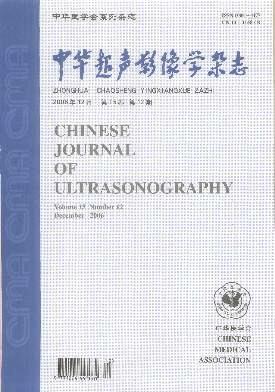胎儿超声心动图在孤立性冠状动脉瘘诊断中的价值
Q4 Medicine
引用次数: 0
摘要
目的探讨胎儿孤立性冠状动脉瘘(CAF)的超声特征。方法对2011年12月至2018年3月收治的13例胎儿孤立性CAF进行回顾性分析。收集超声心动图和随访数据。根据主动脉弓存在舒张期逆行,将所有病例分为逆行组和不逆行组。测量受影响的冠状动脉(CA)和主动脉环(AO)的内径,然后计算CA与AO的比值(CA/AO)。分析了CA、CA/AO与逆行的相关性。随访时记录了不良出生结局,包括流产、心腔增大、肺动脉高压。分析主动脉弓舒张期逆行与不良出生结局发生率之间的相关性。结果①13例胎儿CAF均表现为受累冠状动脉不同程度扩张。13例大动脉或心腔内出现异常血流:心房-冠状动脉瘘出现双相连续血流模式,冠状动脉-心室瘘出现以舒张为主的双相双向连续血流模式。主动脉弓出现逆行全舒张血流7例逆行组CA/AO比值高于非逆行组[(0.63±0.24)mm vs(0.39±0.09)mm P=0.047],两组间CA差异无统计学意义[(3.00±1.25)mm vs(2.03±0.62)mm,P=0.015]。主动脉弓CA/AO比值异常和舒张返流是重要的超声特征,具有预后价值。关键词:超声心动图;胎儿;冠状动脉瘘;主动脉弓逆行本文章由计算机程序翻译,如有差异,请以英文原文为准。
The value of fetal echocardiography in the diagnosis of isolated coronary artery fistula
Objective
To investigate the ultrasonic features of fetal isolated coronary artery fistula (CAF).
Methods
A total of 13 cases of fetal isolated CAF from December 2011 to March 2018 were retrospectively analyzed. Data of echocardiography and follow-up were collected.All cases were divided into retrograde group and no retrograde group based on the presence of diastolic retrograde flow in aortic arch. The inner diameters of affected coronary arteries (CA) and aortic annulus (AO) were measured, and the CA to AO ratios (CA/AO) were then calculated.Correlations between CA, CA/AO and the presence of retrograde flow were analyzed. Adverse birth outcomes including abortion, enlarged cardiac cavity, pulmonary hypertension were recorded at follow-up. Correlation between diastolic retrograde flow in aortic arch and the rate of adverse birth outcomes was analyzed.
Results
①Thirteen cases of fetal CAF were characterized by the varying degrees of dilation of affected coronary arteries. Thirteen cases were presented with abnormal blood flow in the large arteries or cardiac cavities: biphasic continuous flow pattern in atrio-coronary fistula and biphasic bidirectional continuous flow pattern with a diastolic dominant flow in coronary artery to ventricle fistula. Seven cases were presented with retrograde holodiastolic flow in aortic arch. ②The CA/AO ratios of retrograde group was higher than in no retrograde group [(0.63±0.24)mm vs (0.39±0.09)mm, P=0.047], there was no significant difference of CA between the two groups [(3.00±1.25)mm vs (2.03±0.62)mm, P=0.115]. ③The rate of adverse birth outcomes in retrograde group was higher than in no retrograde group (80% vs 20%, χ2=4.80, P=0.028).
Conclusions
Fetal isolated CAF has distinct ultrasonic features. Abnormal CA/AO ratio and diastolic retrograde flow in aortic arch are significant ultrasonic features and has prognostic values.
Key words:
Echocardiography; Fetus; Coronary artery fistula; Retrograde flow in aortic arch
求助全文
通过发布文献求助,成功后即可免费获取论文全文。
去求助
来源期刊

中华超声影像学杂志
Medicine-Radiology, Nuclear Medicine and Imaging
CiteScore
0.80
自引率
0.00%
发文量
9126
期刊介绍:
 求助内容:
求助内容: 应助结果提醒方式:
应助结果提醒方式:


